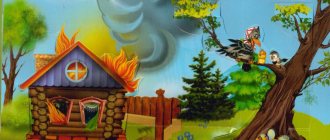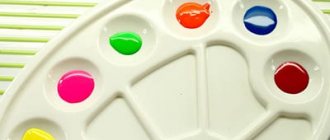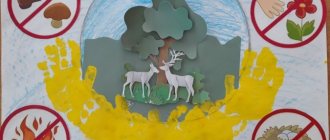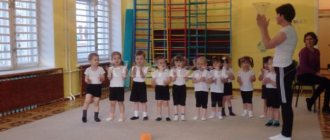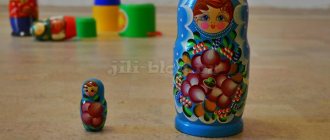11.Big or small?
Goal: to teach children to correlate the words “big” and “small” with the size of objects. Materials: in this game you can compare any toys and objects; You can use pictures in further work. Progress of the game: When forming the concepts of “big” and “small”, it is useful to teach children to use expressive gestures: “big” - spread your arms to the sides (or simultaneously up and to the sides), “small” - bring your palms closer to each other (or bring your hands closer to each other). index and thumb towards each other). To do this, the speech therapist constantly uses these gestures and encourages children to use them. The names of concepts should be highlighted in speech. Show the children the big and small balls. Look, here's a ball, and here's a ball too. Are the balls the same? No, the balls are different. This ball is big! (the speech therapist shows the appropriate gesture), and this ball is small (the speech therapist shows the appropriate gesture). What kind of ball is this - show me. (the speech therapist encourages the children to show the gesture) That’s right, small. What is this ball? Show! (the speech therapist encourages the children to show a gesture) It is useful to repeat this game using a variety of subject material.
The first session of a speech therapist with a child: where to start
Speech therapy classes are carried out for the following purposes:
- Understanding native speech, observing and comprehending everything that happens around. This is how the child learns about the world around him. The speech therapist forms general concepts, gives the basics of word formation, and teaches how to use complex phrases.
- Formation of correct pronunciation of words and development of phonemic hearing. Monitoring the clarity and expressiveness of speech.
- Teaching independent speech using different sentences.
Many people are interested in how the first speech therapist session is conducted. The first session of a speech therapist with a child, where to start:
- The child's disposition towards himself.
- Carrying out diagnostics and identifying problems.
- Introduction to the speech apparatus.
- Teaching simple speech therapy exercises and games.
- Building a work plan.
Literature to help the speech therapist: Fadeeva Yu. A., Pichugina G. A., “Speech therapy classes in the younger group”
The abstract by Fadeeva and Pichugina is intended for speech therapy classes in the younger group. It promotes the formation of speech skills in children two to three years old who have various speech problems of different etiologies. It is intended for speech therapists, speech pathologists, educators and parents.
Stages of working on a new word in speech therapy
Stages of working on a new word in speech therapy:
- Determining the relationship between a sound word and a visual, auditory and other image.
- Analysis of word composition.
- Identification of semantic features of a word.
- Introduction of a word into the semantic field.
- Consolidating the meaning of a word.
9.A lot or a little?
Goal: to teach children to correlate the words “one”, “many”, “few” with the corresponding number of objects. Materials: in this game you can use small toys - cubes, sticks, balls, etc. Progress of the game: When forming the concepts of “one”, “many”, “few”, it is useful to teach children to use the appropriate gestures: “one” - show the index finger; “a lot” - a wide, circling hand gesture; “little” - a narrow, outward gesture with the hand, or fold your palms into a handful. To do this, the speech therapist constantly uses these gestures and encourages children to use them. The names of concepts should be highlighted in speech. The game is played on the carpet. Lay out the cubes in front of the children: one pile has a lot of cubes, and the other has few. Look, here are the cubes, and here are the cubes too. There are a lot of cubes here (the speech therapist shows the corresponding gesture), but there are few cubes here (the speech therapist shows the corresponding gesture). Show where there are few cubes. How do you show that there are not enough cubes? (the speech therapist encourages the children to show a gesture) Where are there a lot of blocks? How do you show that there are a lot of cubes? (the speech therapist encourages the children to show a gesture) And here is one cube. (the speech therapist shows the appropriate gesture) Take one cube at a time. Show that there is only one cube. (the speech therapist encourages the children to show a gesture) It is useful to repeat this game using different subject material.
Groups of words suggested for memorization.
1. Subject dictionary.
Toys: ball, cube, car, doll, bear, bunny, ball, spinning top, bucket, shovel, pencils, book, etc. Parts of the body, face: legs, arms, belly, back, finger, head, neck, hair, eyes , ears, mouth, lips, teeth, nose, cheeks, eyebrows, forehead. Clothing and footwear: hat, scarf, mittens, jacket, coat, dress, skirt, blouse, shirt, trousers, tights, briefs, T-shirt, socks, slippers, boots, shoes, sandals, etc. Toilet items: soap, toothbrush, toothpaste, sponge, towel, comb, handkerchief, etc. House, apartment: house, door, lock, key, stairs, elevator, window, kitchen, room, bathroom, lamp, floor, ceiling, wall, etc. Furniture: table, chair, sofa, bed, wardrobe, shelf, hanger, etc. Household items: TV, telephone, clock, stove, refrigerator, fork, spoon, plate, cup, blanket, pillow, mirror, etc. Food and dishes : bread, bun, cheese, sausage, sausages, milk, butter, sour cream, cottage cheese, yogurt, cookies, juice, egg; porridge, soup, salad, sandwich, tea, compote, etc. Vegetables and fruits: cabbage, potatoes, carrots, onions, cucumbers, tomatoes; orange, banana, apple, pear, plum, etc. Plants: tree, bush, grass, flowers, berries, etc. Names of animals and birds that the child often sees: dog, cat, bird, dove, sparrow, crow, horse, etc. etc. Individual names of objects in the surrounding life: street, road, traffic light, cars, plane, swing, slide, park, etc. Individual names of phenomena in the surrounding life: water, earth, sun, sky, rain, snow, night, day, etc.
2. Verb dictionary.
The child’s own actions: walks, sits, stands, runs, jumps, sleeps, eats, plays, draws, builds, walks, rolls, washes, bathes, dresses, undresses, combs his hair, carries, falls, screams, speaks, sweeps, wipes and etc. Names of actions that people close to the child perform: reads, writes, draws, cleans, washes, irons, cooks, fries, sweeps, etc. Other actions: the phone rings; the car drives and hums; The plane is flying; leaves are falling, etc.
3. Adjectives, adverbs.
Names of some sensations and states: sweet, salty, sour, wet; cold, warm, hot, painful, tasty.
The name of some concepts: big, small; a lot, a little.
Work to expand the passive vocabulary of non-speaking children 2-3 years old is carried out both by a speech therapist and by the child’s relatives. Therefore, a speech therapist not only works with the child, but also works with parents.
